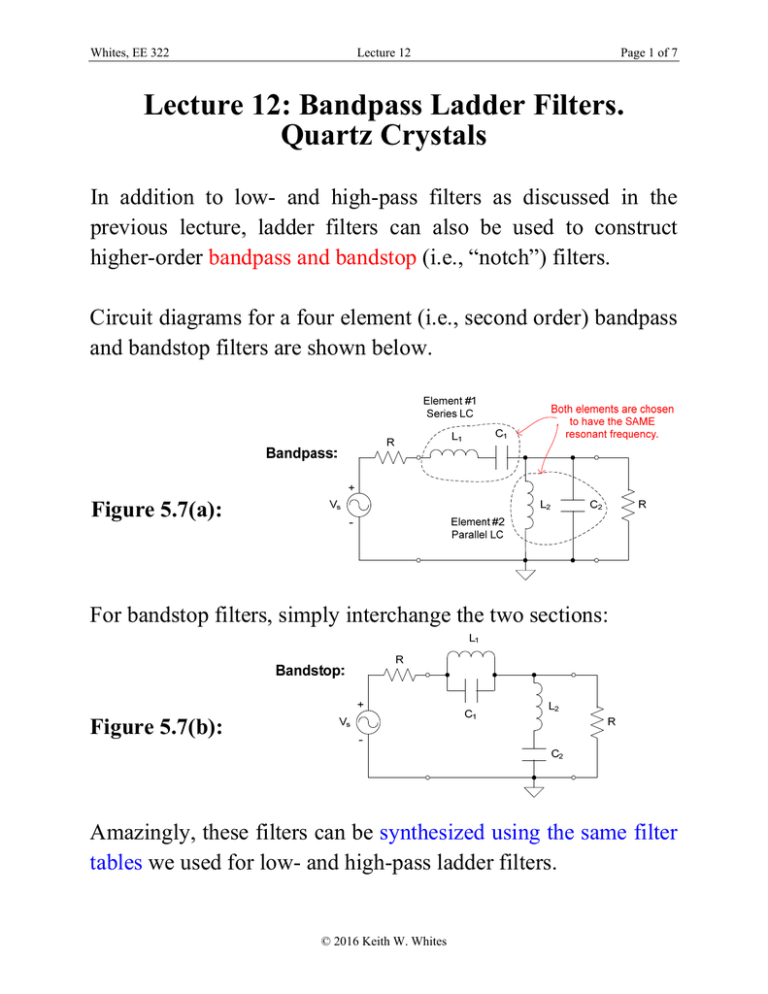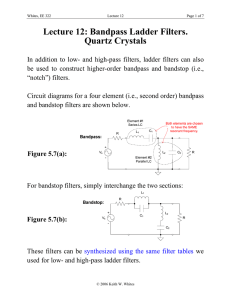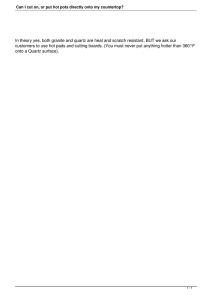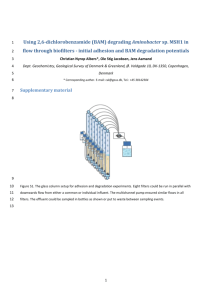Lecture 12: Bandpass Ladder Filters. Quartz Crystals
advertisement

Whites, EE 322 Lecture 12 Page 1 of 7 Lecture 12: Bandpass Ladder Filters. Quartz Crystals In addition to low- and high-pass filters as discussed in the previous lecture, ladder filters can also be used to construct higher-order bandpass and bandstop (i.e., “notch”) filters. Circuit diagrams for a four element (i.e., second order) bandpass and bandstop filters are shown below. Figure 5.7(a): For bandstop filters, simply interchange the two sections: Figure 5.7(b): Amazingly, these filters can be synthesized using the same filter tables we used for low- and high-pass ladder filters. © 2016 Keith W. Whites Whites, EE 322 Lecture 12 Page 2 of 7 However, there are some important differences. Here is the procedure for a bandpass filter: 1. The filter tables are used to compute the series inductances and shunt capacitances as we did with the low-pass filter. 2. When un-normalizing, use the 3-dB bandwidth rather than c to find the L’s and C’s. 3. Finally, compute the series C’s and parallel L’s using the resonant frequency condition 0 1 LC . We will now consider the same example shown in the text on pp. 104-105. (In Prob. 8 you will build and test the series LC network portion of the RF Filter.) Example N12.1: Here we will design a second order Butterworth bandpass filter (Fig. 5.7a) using L1 and C1 as one section. We require that f0 = 7 MHz and R = 50 . With L1 and C1 specified, we have one half of the filter already: 1 2 L1 = 15 H, C1 = 0 L1 = 34.5 pF. Now, from Table 5.1, a1 2 . Recall that X L a1 L R R 6 Consequently, a1R 15 10 4.71 106 rad or f = /2 = 750 kHz. This f is the 3-dB bandwidth of the filter. (At 7 Whites, EE 322 Lecture 12 Page 3 of 7 MHz, this f is somewhat large, meaning this is a relatively lowQ filter.) Next, using the filter table again, we will determine the shunt C2 from a 2 C a2 2 2 6.00 nF. or C2 2 6 G R 50 4.71 10 Finally, using 0 1 L2 LC then 1 8.62 108 H = 86.2 nH. 2 0 C2 The complete filter design is shown below (Fig. 5.8): 50 L1=15 H C1=34.5 pF 86.2 nH 6.0 nF 50 Close to the input model of the transformer T2! While this example was seemingly just an exercise, believe it or not, the actual RF Filter in the NorCal 40A is a two-element Butterworth bandpass filter! L1 and C1 are the series L and C, but where is the parallel L and C? This second section is provided by the primary winding of T2 ( 66 nH). The transformer also transforms the impedance of C2 Whites, EE 322 Lecture 12 Page 4 of 7 to the primary side (you’ll see this later in Lecture 15). Consequently, C p 20 nF or so. That’s just what’s needed for this second order Butterworth bandpass filter! You’ll see more with this aspect of the RF Filter in Prob. 16 when you construct and install T2. Quartz Crystals The maximum Q (minimum bandwidth) of LC ladder filters is usually limited by the inductor Q (i.e., the inductor losses). Other types of resonant elements must be used if Q’s higher than a few hundred are desired. Such Q’s are useful from audio to microwave frequencies. Quartz crystals are one such element. These are made from silicon dioxide, which is cheap. The Q’s of such quartz crystal resonators range from 25,000 to 150,000! Another advantage is that a small temperature coefficient can be obtained for quartz crystals. This is useful so that the resonant frequency drift with temperature is minimized as the transceiver warms up, or in other situations. Whites, EE 322 Lecture 12 Page 5 of 7 Quartz crystals make good electrical resonators because of the piezoelectric effect. This effect is a combination of a mechanical vibration and bound electric charges. When a quartz crystal is squeezed, a voltage is produced: Quartz F F V E Electric starters for gas furnaces, water heaters, and grills use such a piezoelectric effect. This piezoelectric effect also works the other way. A voltage applied across a quartz crystal causes a small expansion of the crystal (Fig. 5.12): Quartz F F V E A microscopic view of the atoms in the quartz lattice helps us understand this piezoelectric effect (Fig. 5.12): Whites, EE 322 Lecture 12 Page 6 of 7 No Applied Force With Applied Force - - + Oxygen + + Silicon - - + F + - + F - + The "charge centers" for positive and negative charge have shifted. There is now an average electric field in the crystal. By symmetry, the "center of charge" is zero. Therefore, the average electric field is zero in the crystal. These quartz crystals can be modeled as RLC filters in electrical circuits: Quartz crystal Rs X + Vs R Vo - The equivalent electrical circuit for the quartz crystal is You will operate your quartz crystals in series resonance in the NorCal 40A. Why is there variation with frequency? Because the mechanical vibrations of the lattice will not be as favorable for all Whites, EE 322 Lecture 12 Page 7 of 7 frequencies of voltage excitation. At some frequencies, the lattice vibrations are maximum.






